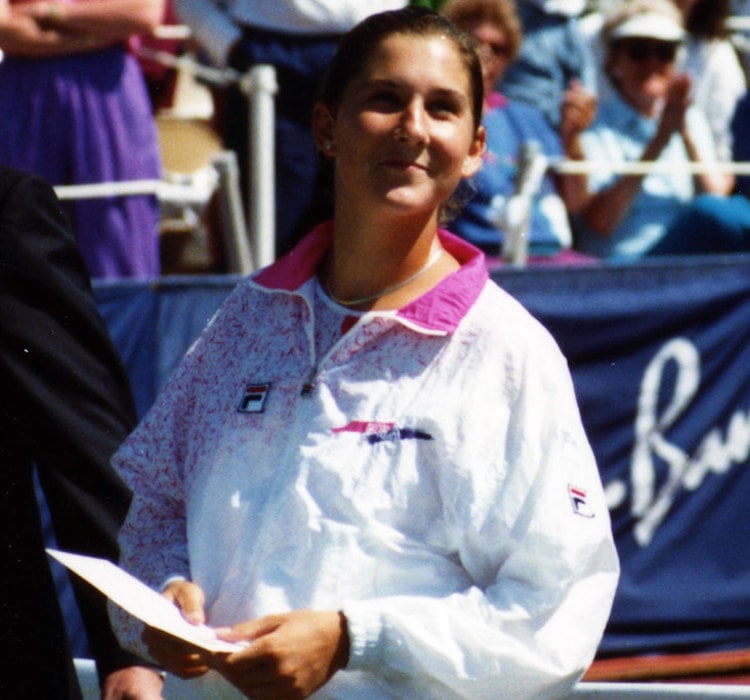Remembering The Darkest Day In Tennis History
Yugoslavian-born Monica Seles was a professional tennis player. Before the age of 20, she won eight Grand Slam (“Majors”) single tournaments and was ranked number 1 in the world. But a deranged man with a 9-inch knife effectively ended what looked to be one of the most promising careers in tennis history. What could have been done to stop him, and what measures have been taken to prevent such an act from happening again?

Monica Seles, Teenage World Champion
Grand Slam annual tournaments are the most important championships in tennis and are played as the Australian Open, French Open, Wimbledon, and the US Open. To achieve a “Grand Slam,” a player must win all four majors in a single year.
Seles and her brother immigrated to the United States from Yugoslavia in 1986. Seles trained heavily on the tennis court until early 1990. That year, she became the youngest ever champion by winning the 1990 French Open at sixteen years old. And her winning streak would continue.
Before she turned 20, Seles won seven more Grand Slam singles titles. She dominated and replaced Steffi Graf as the number one ranking tennis player in 1991 and 1992, and she showed no signs of slowing down.
Brutal Attack
This all changed on April 30, 1993, when Seles was in the middle of a quarterfinal match in Hamburg, Germany. Tennis players switch sides at designated times during a match, called a changeover. This changeover is to ensure fair play, and allow for a brief rest, one that can also double as a restroom break.
During one such changeover, Seles was resting in courtside seating when an unhinged man leaned over the spectator fencing and attacked her. The 9-inch (23-cm) long boning knife he used to stab her between the shoulder blades narrowly missed her spine and major organs. The attacker, Gunter Parche, was later found to be an overly invested Steffi Graf fan. Parche was upset over Graf’s displacement as leading world champion and evidently hoped to remove Seles from the equation so Graf could regain her title.

No Justice for Seles
Although many people directly witnessed the attack, Parche’s six-month pre-trial detention would be the only time he spent in jail. The court judge at trial found Parche to be mentally unstable. What was the inconceivable judgment? A grievous bodily harm conviction but a suspended sentence of probation for two years with mental health treatment.
In the aftermath of the attack and unjust rulings, Seles suffered from PTSD, depression, and an eating disorder. Along with her father’s cancer diagnosis and subsequent death, she remained off the professional tennis court for two years. The overly lenient verdict had been challenged amidst widespread public outrage, and a retrial finally commenced in 1995. The second trial judge amazingly upheld the suspended sentence, citing Parche’s lack of criminal record and the defense’s assertions that he wasn’t trying to kill Seles, “only” take her out of action so Graf could reclaim the lead spot. In the end, Parche was effectively a free man.

Seles’ Limited Return
Seles returned to professional tennis in 1995 but refused to play in Germany again. She won the 1996 Australian Open title, her eighth Grand Slam singles championship title. However, her best form was inconsistent, and she seemed to have lost a lot of her pre-attack fire on the court. Her last professional match was the 2003 French Open. After some exhibition matches against other ranking players, she officially retired in 2008. Who knows what she could have achieved, if not for one deranged man and lax security?

The Takeaway
What did the tennis world learn from this horrifying incident? Security should always be a fluid measure. It is not enough to retroactively respond to the last incident. Careful and educated foresight must be employed to determine holes in security measures.
However, both liberty and good market sense must also be considered. Too little security brings one type of risk; too much security can be financially detrimental. If people are too inconvenienced, for example, they might stop buying tickets to attend events. So where is the fulcrum in this delicate balance?
Despite tightened security measures after the Seles stabbing, there have been security breaches of the court by overeager, but fortunately benign, spectators. While the market might call for fan intimacy with the players, especially with increased courtside seating, what of the players’ safety from the next Parche?

